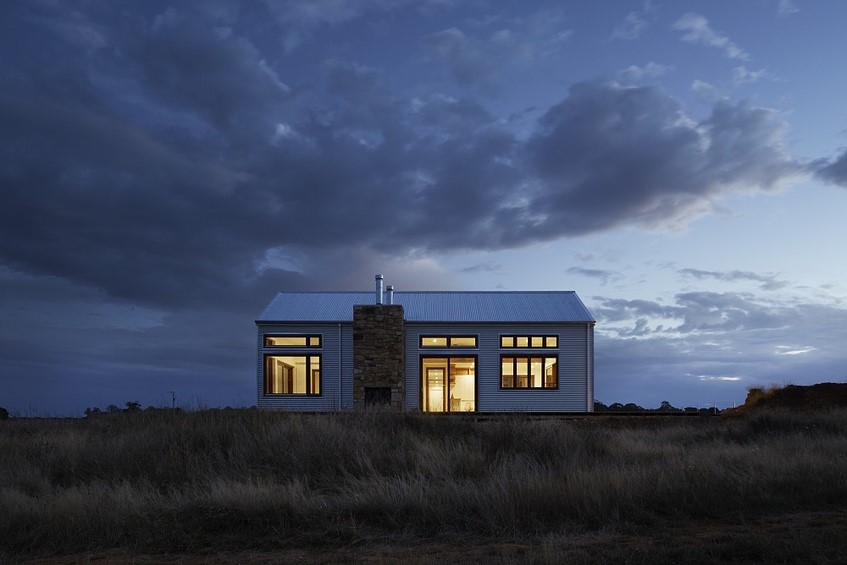
The climate of the local area and the positioning of a home will affect its overall energy star rating. Image: Peter Clarke
Give me a home among the gum trees. Or high rises. Or the suburbs. Give me a metal roof, some brick veneer walls and a concrete floor. That’ll put me on par with the average newly-constructed home in Australia. It seems that that’s where our tastes lie, but how energy efficient are these features?
Around 11.4% of Australia’s emissions can be attributed to households, and with construction continuing at a steady pace, it’s important that we keep an eye on our energy efficiency efforts. We’ve launched the Australian Housing Data (AHD) Portal to do just that and, as always, the truth is in the data.
All the stars
Energy star ratings for homes were introduced in 2001. It’s a scale of 1-10 stars, describing the ‘thermal performance’ of a home – that is, how much heating or cooling is required to make it comfortable. Star ratings are based on information about the home’s design, construction materials and where it’s built. For example, if your home capitalises on local breezes and is positioned to maximise the sun’s path, it may have a higher star rating. But a traditional breezy ‘Queenslander’-style home built in a cooler climate may be rated lower. It’s all about staying comfortable and using less energy when temperature extremes are upon us.
Back in ’01, the energy efficiency of the average home was 1.8 stars. Here’s a progress snapshot of just how far we’ve come since then:
| Houses | Apartments | |||
| State | Star rating | Size (m2) | Star rating | Size (m2) |
| ACT | 6.9 | 141 | 7.4 | 75 |
| NSW | 5.9 | 146 | 6.3 | 77 |
| NT | 6.3 | 117 | 7.7 | 61 |
| QLD | 6.4 | 125 | 6.1 | 82 |
| SA | 6.3 | 134 | 6.4 | 69 |
| TAS | 6.5 | 117 | 7 | 92 |
| VIC | 6.2 | 155 | 6.8 | 61 |
| WA | 6.1 | 148 | 6.8 | 75 |
| National | 6.2 | 144 | 6.4 | 75 |
We can see that the average newly-constructed home in 2018-19 had an energy rating of 6.2 stars. If we compare it to the 2001 average of 1.8 stars, this translates to an annual saving of approximately $560 in energy bills and 2.3 tonnes of CO2 equivalent (tCO2-e) in greenhouse emissions per house. Great news for both the hip pocket and the environment.
Kudos is due to the ACT and Tasmania, with both houses and apartments falling well above the national star rating average. The data also shows that Victoria and the Northern Territory are building very efficient apartments, although they are among the smallest in overall size (and built in fewer numbers in the NT).
While star ratings give an overall efficiency rating for our homes, they’re limited to the building itself – not appliance use.
There are a number of other measures that can be taken to ensure we stay comfortable throughout the seasons. Energy consumption by hot water systems, lights or household appliances is not considered in the rating because these fittings are usually replaced several times during the life of the building. We’ve put together some suggestions on staying warm in winter and cool in summer.

Energy star ratings determine the ‘thermal comfort’ of your home, which is the amount of heating or cooling required to achieve your preferred temperature.
Data-driven dreams
In addition to overall energy rating information, our AHD Portal information can be further broken down by design (e.g. dwelling class and floor area), construction (e.g. type of walls and roofing) and fixtures (e.g. solar PV and heating/cooling systems). Another interesting tidbit is that our homes are gradually increasing in size, which may spell the difference if you’re deciding between a 55 or 65” flat screen (the most energy efficient model, of course).
Our Grids and Energy Efficiency Research Director Dr Stephen White said the data shows steady progress in residential sustainability efforts.
“In order to meet national challenges of sustainable energy and resilient cities, it’s vital that we track progress. It’s an important step to ensure emissions goals are met, while seeing where more attention is needed across the industry,” Stephen said.
We’ll update dashboards in the AHD Portal frequently, ensuring it is a relevant and accessible tool for the benefit of residential energy efficiency stakeholders across the country.


16th May 2019 at 10:54 am
We built a passive solar house in 2003 with over 9m of glass facing North, using ComfortPlus glass which delivered much of the benefit of double-glazing but substantially cheaper. It was a laminate that fitted standard frames. We’re now in a house with even more glass facing North but it was built by people who didn’t know about such glass (ironically, by the same builder around the same time).
I’d love to have a chance to apply some kind of film to our glass to regain those benefits. The house warms up in winter but cools rapidly at night and similarly during summer suffers from direct conductive heat transfer through the glass.
22nd April 2019 at 12:20 pm
Good on you Bernie. We knew all about Passive Solar Design back in the 60’s but so few houses use anything of its principles still and the Govt. regs do not seem to help. If the house is facing wrong, not got any thermal mass all they do is bump up insulation and put in db glazed windows which are expensive with much more affordable alternatives available. We just need to do so much more in new and reno construction.
20th April 2019 at 8:14 am
We designed and built a house in the late 80s it was a double brick, two storey, conventional looking dwelling in rural Tasmania, it faced north, hot water and cooking was by means of a slow combustion stove, winter heating was by a smallish wood heater. In summer the lower story was delightfully cool due to the thermal mass of the bricks and also to a full length north facing pergola clad in grape vines; in winter, even though we regularly registered minus 6 degrees the house remained beautifully warm, our heater was lit every day at about 3 pm and allowed to go out overnight.
19th April 2019 at 6:45 pm
The number of new dwellings in WA built with (fashionable) black tile roofing never ceases to amaze me. Surely this will result in greater heat absorbing in our increasingly hot summers?
16th April 2019 at 3:51 pm
I think the passive solar designed house that we had built in 1982 has been a great success, with electricity bills less than a quarter of the average for a house of our size. Solar PV and a solar hot water system helps of course, along with 2 wood fires, but there is virtually no media publicity selling the merits of energy efficient houses.